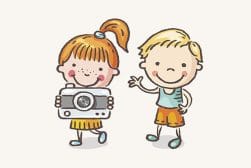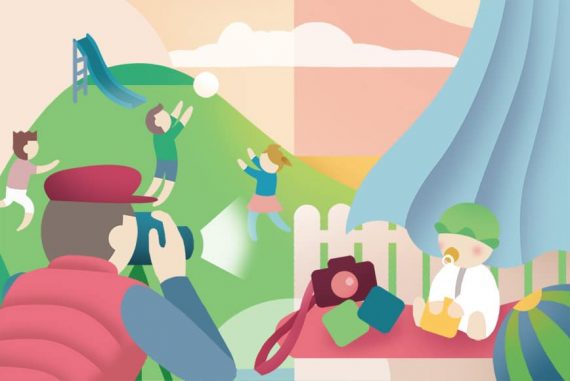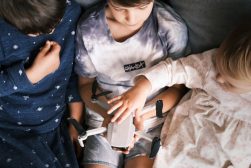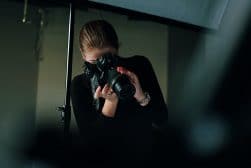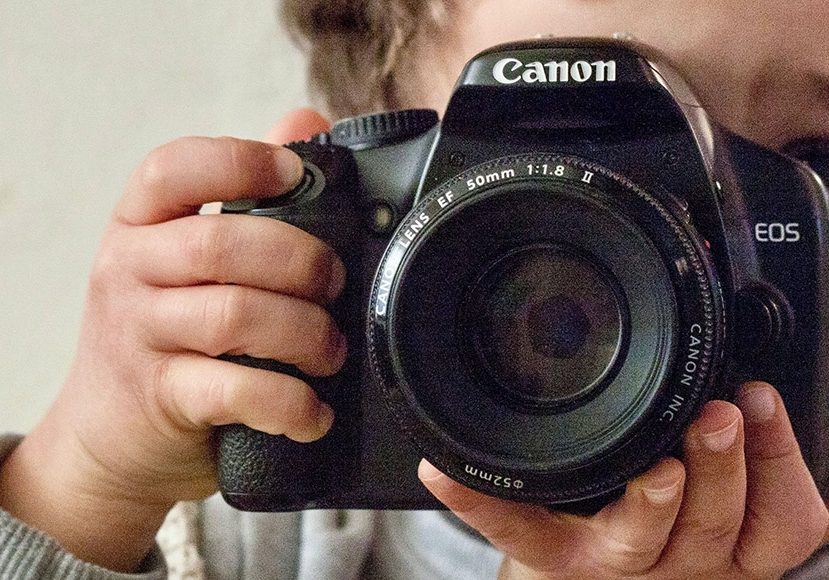
Photography for Kids: Fun Activities, Latest Lesson Plans & Tips
It's never too early to pick up a camera. Learn how to get your kids or students motivated and excited to start photography with these top tips and lessons.
Learn | By Jeff Collier
Photography is a fun and creative activity that can be enjoyed by people of all ages, including kids.
It allows children to express themselves, explore their surroundings, and develop their artistic skills.
I’m a photographer and want my grandkids to learn how to take pictures on cameras (as opposed to just my iPhone!) – maybe you’re in the same boat?
In this article, I’ll show you how you can teach your child to take pictures, whatever their age.
You’ll even find some fun photography activities and lesson plans that can be tailored to kids and students.
(You may also be interested in our article on how to photograph children.)
Let’s dive in!
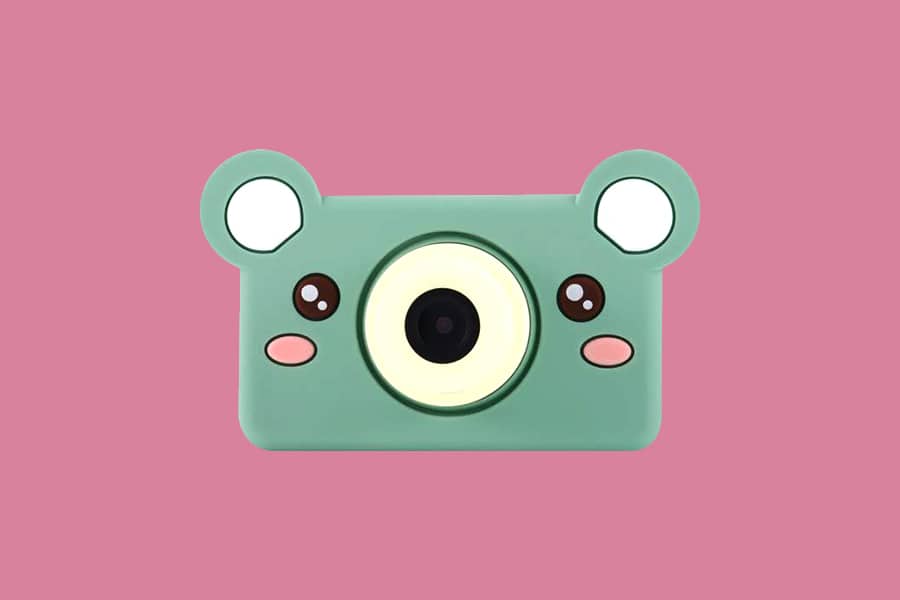
The Kidamento digital camera is cute, easy to use and packed full of fun features. Available as a sloth, cat or a koala.
Photography for Kids: How Do I Teach My Child to Take Pictures?
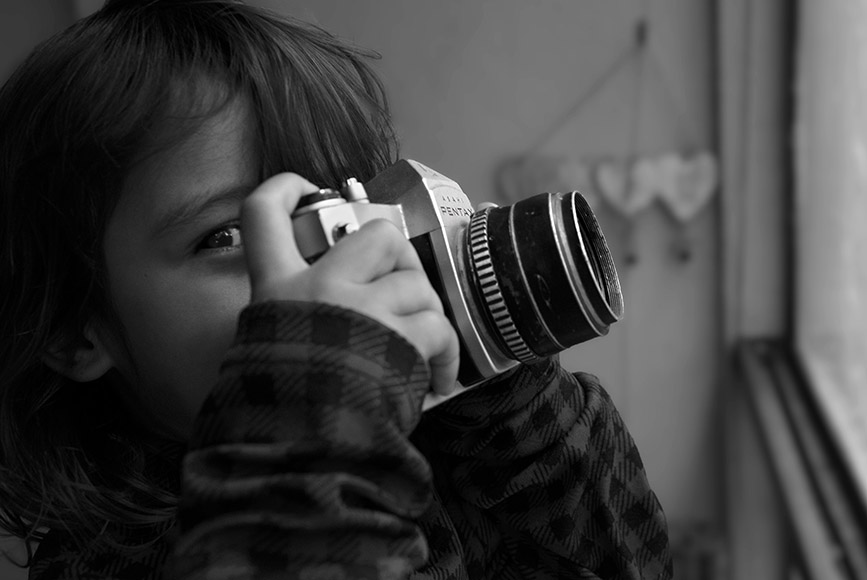
Raíssa de Paula
Photography for kids is an exciting topic, especially if you’re a parent and want to pass on your passion for digital photography.
Teaching your child to take pictures is a great way to help them develop their creativity and technical skills.
Here are a few tips on how teach photography to children:
- Start with a simple camera: Unlike regular photography, kids’ photography should be as simple as pointing and shooting. Children may not have the patience or coordination to use a complicated camera, so it’s best to start with a simple point-and-shoot camera or even a smartphone. You may also want to invest in one of these kids’ cameras which are a fun design.
- Explain the basics: Photography lessons for kids should emphasize fundamentals. Show your child how to turn the camera on and off, how to focus, and how to take a picture. Teaching photography needn’t be dry or boring – keep it simple to start with.
- Encourage creativity: Encourage your child to take pictures of whatever interests them, whether it’s a tree in the park or their favorite toy. Take a step back and forget about all the usual photography tips and any photography skills you’ve picked up along the way – just let them take a few photos of whatever they want, however they want.
- Offer guidance: Offer guidance and suggestions, but also give your child the freedom to experiment and make their own decisions. Remember – these aren’t structured photography lessons, per see – think of it more as playtime with a camera.
- Review and discuss the pictures: After your child has taken some pictures, sit down with them and review the pictures together. Ask them what they like about each picture and what they might do differently next time.
It may be interesting for kids to learn that digital photography is a relatively new ‘invention’, and that back in your day, everything had to be printed.
At What Age Can Kids Start Photography?
There is no specific age at which kids can start photography, as it depends on the child’s maturity and ability to handle a camera.
Some children may be ready to start taking pictures at a young age, while others may need to wait until they are older.
Here are a few factors to consider when teaching photography to younger kids:
- Physical ability: Children should be able to hold and handle the camera securely and press the button to take a picture. Obviously, this will depend on the size and shape of the camera – Kidamento makes this one that’s easy to grip for smaller hands.
- Attention span: If the child able to focus on taking pictures and not get easily distracted?
- Understanding of instructions: The child should be able to understand and follow basic instructions, such as how to turn the camera on and off and how to focus.
- Interest: Is the kid showing an interest in taking pictures, and are they motivated to learn? Do they want to have their own camera? Are they asking for photography lessons?
If your child meets these criteria and is interested in basic photography, they are likely ready to start taking pictures.
Is Photography a Good Hobby for Kids?
Photography can be a great hobby for kids because it allows them to express themselves creatively and develop their artistic skills.
It can also help children learn to see the world in a different way as they start to notice details and compositions that they might have otherwise overlooked.
Remember the saying, “see the world in the way a child sees it”? This applies to photography for kids – they’ll take pictures of things you never even considered before.
Photography can also be a great way for children to document their experiences and memories.
In addition, photography can help children develop important life skills, such as problem-solving and communication.
How Much Do You REALLY Know About Photography?! 🤔
Test your photography knowledge with this quick quiz!
See how much you really know about photography...

They may need to think creatively to capture a unique shot or communicate with members of their family or their friends when taking pictures of people.
Overall, photography can be a rewarding and enjoyable hobby for kids as long as they are interested and motivated to learn.
14 Photography Activities for Kids and Students in 2023
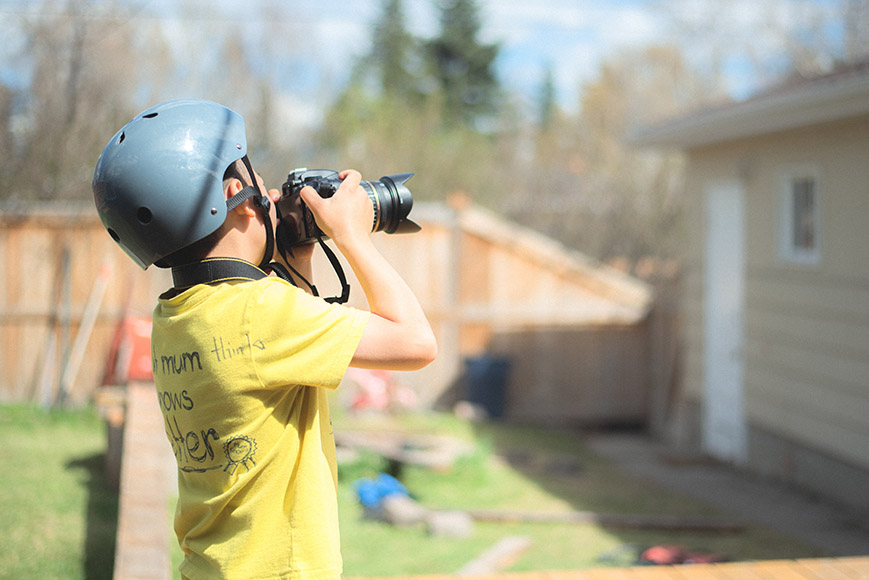
Ryunosuke Kikuno
Here are seven fun photography activities that kids can try:
- Self-portraits: Here’s an easy photography activity for students. Encourage the child to take self-portraits using your smartphone or a digital camera. They can experiment with different angles, lighting, and expressions to create unique self-portraits. Give them a few basic photography tips (like using a tripod and the self-timer), but then leave them to figure the rest out themselves.
- Nature photography: Take a walk with the child and encourage them to take pictures of plants, flowers, and animals. They can also try taking close-up shots of flowers or other small objects to focus on details. Young photographers will always love getting out in nature with a camera.
- Black and white photography: Try taking pictures in black and white to create a different look and feel. This can also help kids learn about how color affects an image.
- Action shots: Encourage your child to take action shots of people or animals in motion. This can be challenging, but it’s also a great way to practice capturing movement and freezing it in a photograph.
- Still life photography: Set up a still life scene using household objects and encourage your child to take pictures of it. This can be a great way for kids to practice composition and lighting.
- Street photography: Take a walk with your child and encourage them to take pictures of people and scenes from everyday life. This can be a great way for kids to practice candid photography and capture candid moments.
- Night photography: Try taking pictures at night to capture the beauty of the stars or the city lights. This can be a fun and challenging activity that allows kids to experiment with low-light photography.
- Photo editing: Photography for kids needn’t just be about taking photos. Show them how you can change the look of digital photography using a simple editing app like the one found on your smartphone. See what effects the child likes applying to their photos.
If you’re looking for photography activities for students, here’s a list of seven more:
- Landscape photography: Encourage students to go outside and take pictures of landscapes, including mountains, forests, and beaches. This can be a great way for students to practice composition and lighting.
- Portrait photography: Students should practice taking portraits of their classmates or friends. Encourage them to experiment with different angles and lighting to create unique and interesting portraits. Experiment with different lenses to see how they affect the look of their friends’ faces.
- Architecture photography: Encourage students to take pictures of interesting buildings or structures in their community. This can be a great way for students to practice composition and capturing the details of a scene.
- Food photography: Have students practice taking pictures of food. This can be a fun and creative activity that allows students to experiment with lighting and composition. See if they can guess how these food photos were taken.
- Product photography: Encourage students to take pictures of products, such as their own toys or electronics. This can be a great way for students to practice capturing detail and showcasing the features of a product.
- Street photography: Have students take candid pictures of people and scenes from everyday life. This can be a fun way for students to practice candid photography and capture candid moments. You may also need to teach them the local laws about taking photos of strangers.
- Night photography: Encourage students to try taking pictures at night to capture the beauty of the stars or the city lights. This can be a fun and challenging activity that allows students to experiment with low-light photography, and blurring lights with slow shutter speeds.
Teaching photography to students is immensely rewarding.
Just remember to keep your photography lessons light on the technical details initially to ensure that the students’ creativity can flourish – you don’t want to make them bored too early on!
10 Digital Photography Lesson Plans for Elementary Schools
Here are ten photography lesson plans that can be used in an elementary school setting:
- Introduction to Photography: This lesson introduces students to the basic concepts of photography, such as the camera, aperture, shutter speed, and ISO. Students can learn about the different parts of a camera and how they work together to capture an image.
- Composition Basics: Students can learn about the basic principles of composition, such as the rule of thirds, leading lines, and symmetry. They can practice applying these principles by taking pictures and analyzing their compositions for discussions with their classmates.
- Portrait Photography: Students should learn how to take portraits and experiment with different angles, lighting, and backgrounds. They can practice taking portraits of their classmates and friends and learn how to capture natural expressions and emotions in their photos.
- Landscape Photography: Teach how to take landscape photos and experiment with different perspectives, angles, and lighting. They can practice taking photos of the natural environment or urban landscapes and learn about the importance of composition in landscape photography.
- Black and White Photography: In this lesson, students learn how to take black and white photos and how to use contrast and lighting to create dramatic and impactful images. They can practice taking photos in black and white and learn about the history and aesthetics of black and white photography.
- Action Photography: In this lesson, students learn how to capture movement and freeze it in a photograph. They can practice taking action photos of sports, dance, or other fast-moving subjects and learn about the techniques and equipment needed for action photography.
- Night Photography: Students will learn how to take photos at night and experiment with different lighting techniques. They can practice taking photos of the stars, the moon, or cityscapes at night and learn about the challenges and rewards of night photography.
- Still-Life Photography: In this lesson, students learn how to set up and photograph a still-life scene. They can practice using lighting, composition, and props to create an interesting and visually appealing still-life photo.
- Street Photography: Teach students how to take candid photos of people and scenes from everyday life. They can practice capturing candid moments like laughing or talking and learn about the ethics and considerations of street photography, including local laws that affect taking photos.
- Food Photography: Teach how to take appetizing and visually appealing photos of food. They can practice using lighting, composition, and props to create a mouth-watering food photo.
You can find the best photography schools here.
The History of Photography for Kids: A Simplified Summary
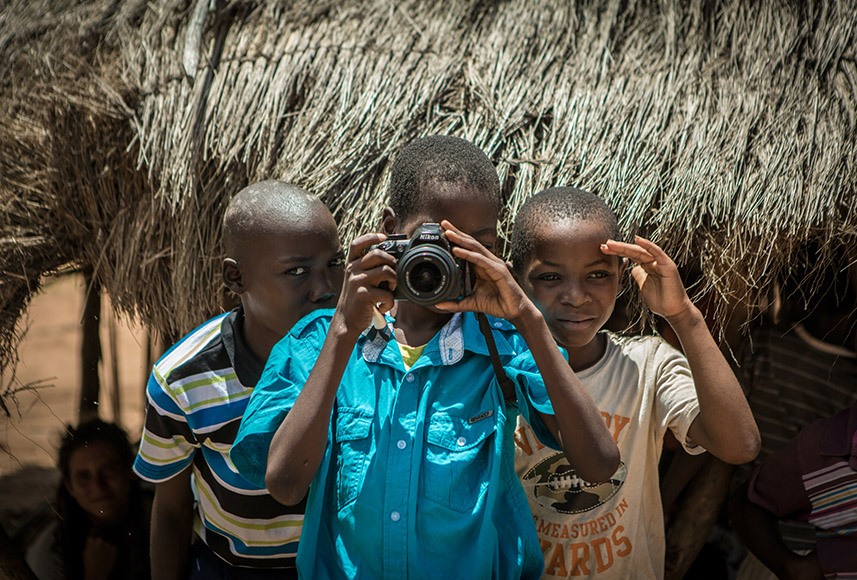
Martin Bekerman
The history of photography is a fascinating and colorful one that dates back over two thousand years.
If you’d like to talk about how it all originated in your photography lessons, here is a brief overview of the history of photography for kids aged 10+.
- The earliest known photograph was taken in the early 19th century by a French inventor named Joseph Nicéphore Niépce. He used a camera obscura (a small, dark room with a hole in the wall) to capture an image of the view from his window. This photograph is called the “View from the Window at Le Gras” and is considered the first photograph ever taken.
- In the 1830s, a British scientist named William Henry Fox Talbot developed a process called “calotype” which allowed people to make multiple copies of a photograph. This process used paper coated with silver chloride, which turned black when exposed to light.
- In the 1850s, a French photographer named Louis Daguerre developed the daguerreotype process, which used a polished silver plate to capture an image. The daguerreotype process produced very detailed and high-quality photographs, but it was expensive and time-consuming.
- In the late 19th century, the wet plate collodion process was developed, which allowed people to take photographs more quickly and inexpensively. This process used a glass plate coated with a chemical mixture that became light-sensitive when wet.
- In the early 20th century, the first color photographs were developed. One of the most popular color photography processes was called “autochrome,” which used microscopic grains of starch dyed in three primary colors (red, green, and blue) to create a color image.
- In the 1950s, the first modern digital cameras were developed, which used electronic sensors to capture images. Today, digital cameras are the most widely used type of camera, and people can take and share photos instantly using their smartphones.
Throughout its history, photography has transformed the way we see and understand the world.
It has also allowed us to capture and preserve memories, document important events, and share our experiences with others.
Photography for kids isn’t just about creativity and camera settings – it’s also important to show them how digital photography came to be, and some of the ‘old story’ of the days of the darkroom too.
See also: when were cameras invented?
Tips for Encouraging Children to Take Photos
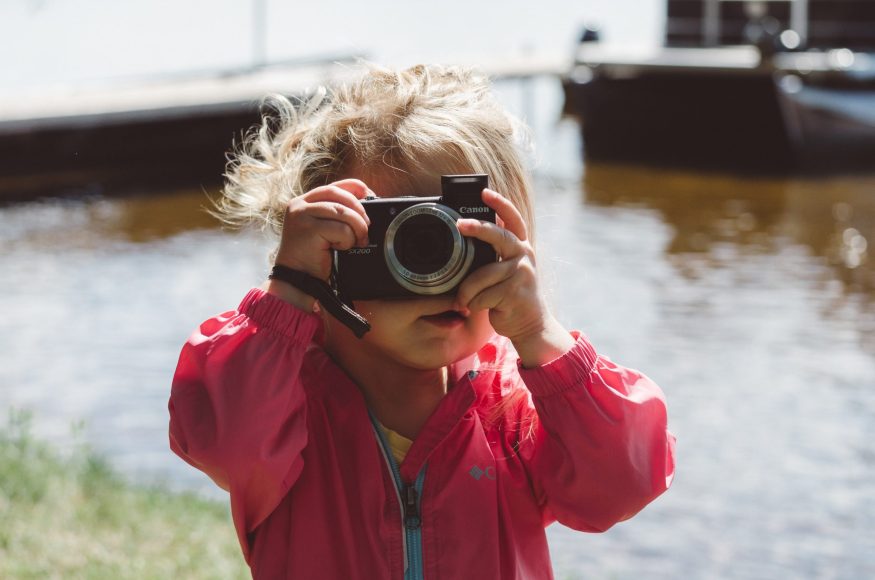
Kelly Sikkema
How do I encourage my child to turn the camera on?
If you want to encourage your child to turn the camera on, you can try the following strategies:
- Make it easy to use: Consider using a camera that is easy for your child to turn on and off, such as a point-and-shoot camera or a smartphone camera. This one from Kidamento is a great choice.
- Show them how: Demonstrate how to turn the camera on and off, and encourage your child to practice doing it themselves.
- Make it fun: Encourage your child to take pictures of things that interest them, such as their favorite toys, pets, or places. This can make taking pictures more enjoyable and motivating. Give the child a camera in the morning and ask them to take 10 photos before lunchtime, for example.
- Offer guidance and support: Offer guidance and support as needed, but also give your child the freedom to explore and experiment on their own. Review the photos the child has taken at the end of the day.
- Be patient: Children may need more time and practice to learn how to turn the camera on and off, so it’s important to be patient and encouraging.
- Reward their efforts: If your child is making an effort to turn the camera on and take pictures, be sure to praise and reward their efforts. This can help them feel more confident and motivated to continue learning.
- Show them your photos: Show some of the first photos you ever took or more recent example photos.
How can I get my 4-year-old to take pictures?
Here are a few tips for encouraging your 4-year-old to take pictures:
- Start with a simple camera: Children at this age may not have the patience or coordination to use a complicated camera, so it’s best to start with a simple point-and-shoot camera or a smartphone camera.
- Explain the basics: Show your child how to turn the camera on and off, how to focus, and how to take a picture. Use simple language and demonstrate the steps using hands-on examples.
- Encourage creativity: Encourage your child to take pictures of whatever interests them, whether it’s a tree in the park or their favorite toy. This can help them feel more motivated and engaged.
- Offer guidance: Offer guidance and suggestions as needed, but also give your child the freedom to experiment and make their own decisions.
- Review and discuss the pictures: After your child has taken some pictures, sit down with them and review the pictures together. Ask them what they like about each picture and what they might do differently next time.
- Be patient: Children at this age may need more time and practice to learn how to take pictures, so it’s important to be patient and encouraging.
By following these tips, you can help your 4-year-old learn to take pictures and have fun with photography.
Download Free Photography Cheat Sheets for Kids
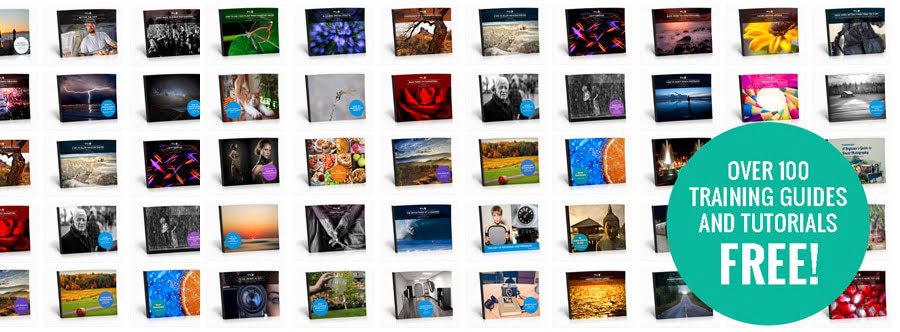
Tons of great free content available to download.
Photzy is a great place to learn photography, with tons of ebooks packed full of photography lessons on everything from basic tips and camera handling skills to taking exhibition-worthy photos.
While much of their content is geared toward students and ‘older’ people, there are also a handful of excellent free photography cheat sheets you can download for kids.
Their e-books are well-designed and informative and provide tons of useful tips to help your photographers improve and get inspired.
You can download three free photography cheat sheets here >>
Final Words on Teaching Photography to Kids
I hope you got some good information about photography for kids from my article.
Most schools offer photography lessons for young students, but I haven’t come across any for younger kids.
That’s why it’s important to encourage younger children to pick up a camera earlier and start experimenting.
A child’s photos are a wonderful thing. Make sure you’re part of the learning process to encourage these new skills.

Check out these 8 essential tools to help you succeed as a professional photographer.
Includes limited-time discounts.





